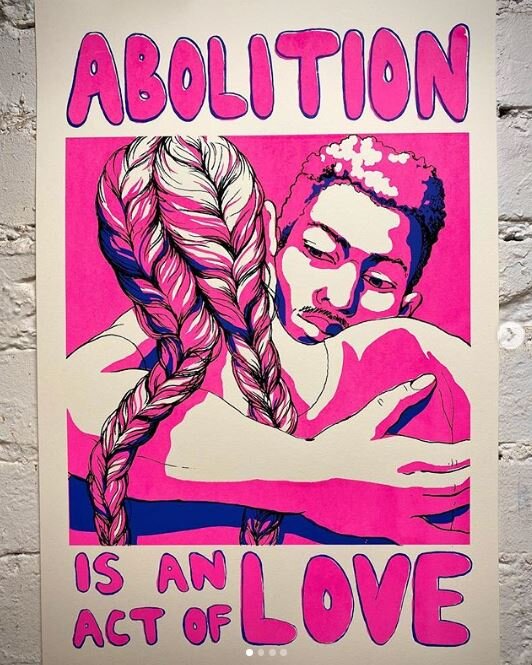how my yoga practice led me to prison abolition
For about six months in 2017, I taught yoga at the Utah State Prison in the Timpanogos Facility. What first drew me to the prison was my commitment to seva, or service in Sanskrit, and my growing acknowledgement to work for racial justice and prison abolition. I knew at the time that building relationships with people who are incarcerated are not only worth our time as we fight for liberation, but it felt important to build relationships with people on the inside so I can personally know who I’m fighting for. I went with the attitude summed up by the quote from Lilla Watson, an Indigenous activist from Australia, that “If you have come here to help me, you are wasting your time. But if you have come because your liberation is bound up with mine, then let us work together.”
When my first class started, I had around 30 students, and each week I’d look forward to seeing their sweet faces. Many expressed how our evening classes were the highlight of their week. One week, however, only six people showed up. When I found out later that the lower turnout was due to a revoking of privileges, I felt angry and upset. I was there to donate my time specifically because I did not believe that yoga should be a “privilege”, but rather another resource they can use to help them heal from the traumas they have faced and continue to live with while locked up.
I learned that for the most part, privileges are revoked not for harmful actions, but rather for breaking the norms of strict control. Some of the basic freedoms that you give up when you’re incarcerated include using the bathroom in private, eating when you want, choosing who you live with, pulling the blanket over your head at night, or not knowing specific policies or procedures. One such example I found that was particularly insulting that warrants punishment: if your cellmate procures a television, gets released, and you keep it after they leave without filling out the proper paperwork, your privileges can be revoked. And of course, all of these “rules” are up to the whims of whoever the guard is, and depends entirely on their mood or relationship to the person breaking such restrictions.
I found an article from the Deseret News that talks about the women I worked with, and how they utilize the gym to help them rehabilitate. It’s from 2010, so it’s dated, but it isn’t far from what my experience was like. In it, they state that 85% of the women at the USP are there for drug use, and most of them used drugs to lose weight. Here was another instance to make it clear to me that prisons are not a place for rehabilitation. We failed to provide resources to deal healthily with body weight and process trauma, and now these women are locked up for it. Then the prison dangles healing tools as a “privilege” to manipulate their actions. Instead of contributing to autonomy they are again reminded that they do not have the freedoms to navigate their own livelihood.
To really let this lesson sink in, they eventually cancelled my program altogether without communicating to me about it. I had to find out by showing up for another class during my scheduled time and wonder why the gym was locked and everything was dark. Eventually a prison guard drove up to me on their golf cart to let me know. No explanation was ever given to me.
This is reflective of the way that prisons prey on marginalized people and leave people in the dark. It is well-known how the system disproportionately targets people of color, immigrants, people with disabilities, and trans and gender non conforming folks. That’s because the history of policing stems from the harmful past of colonization, enslavement, and disdain of workers’ rights. The more I learned about the past, the more I understood the present. Casting a light on our shadows is how we can minimize their impact, and I find the practice of yoga and prison abolition to intertwine well together to consider how we can revolutionize care and mutual aid.
What does ahimsa, or non-violence, mean when we live under the control of a violent state?
Non-violence is a buzz word for many white people, but it can come with a lot of spiritual bypassing and misunderstandings of how violence operates. I want to break down our ideas of where violence is located and how we can work on reducing its power.
A while back I went to a speech about “Yoga Therapy for the Mind” with Arun Deva, and he said something there that has stuck with me since. Paraphrased, he explained that merely existing is violence: eating is violence, to the plant or animal that gives you sustenance, breathing is violence, since it is taking the oxygen in our air, thinking is violence, because it can lead to angry thoughts which lead to angry words and then to angry actions. Other forms of violence exist externally: cultural appropriation and plagiarism are acts of violence. Lying and taking are violent acts. Denying someone healthcare is violence. Not taking care of each other is violence.
Violence can be direct or non-direct, but what it can’t be is non-existent. None of us are innocent of performing violence. We must face that as a truth and sit with it. Our challenge in practicing non-violence, then, is to resist the violent urges within us and within our communities. It is also to recognize where violence is acceptable, or a function of operation, and to draw our attention to that. Non-violence confronts violence by holding up a mirror and exposing the ugly truths that people in power like to pretend isn’t real. In this sense, we must recognize the violence of our government, of the military, of policing, and of prisons. With this information we must question why so many yoga teachers in the US do not feel compelled to engage with radical left politics as part of their practice. We should further be skeptical of yoga instructors who do not wish to engage with politics at all.
As a white American, I must face the fact that I am a a byproduct of violence, of land theft and genocide. I have ancestors who were rewarded for their time served in the military, ancestors who invaded native people’s lands, called it their own, and then rearranged it in unsustainable ways. The advantages I have by being a white person in this world came about by taking away from other people’s lives, family, culture, and resources. These are not things to be proud of and I feel deep shame for the violence I come from. Because of that, I am committed to learning how I can heal the communities I am a part of now. I do that by embracing Black queer feminism. I do that by organizing and showing up to protests. It is why I felt drawn to prison abolition, and it is how prison abolition and yoga have become such profound practices in my life.
I must further confront violence and understand that self-defense and property damage are not acts of violence. I must not judge people if they use violence as a tool to secure resources for their community. If I am to seriously grapple with unsavory realities about violence, I must commit to a redistribution of power. Part of that means recognizing that incarceration, which operates as another source of violence, only reinforces it and does not accomplish what we think it does.
Why prison abolition?
One of the formative books I read that converted me to abolition (and I know this is true for many others who identify as abolitionists) was “Are Prisons Obsolete?” by Angela Davis. In just under 150 pages, Davis spells. it. out. “In the nineteenth century,” she states, “antislavery activists insisted that as long as slavery continued, the future of democracy was bleak indeed. In the twenty-first century, antiprison activists insist that a fundamental requirement for the revitalization of democracy is the long-overdue abolition of the prison system.” (39)
Instead of engaging with our community and finding the gaps where resources need to be focused, like in education or healthcare, prisons allow us to place people out of sight to relieve us of any further responsibility to them. It may be easier to lock someone away than it would be to engage with them in therapy, for example, but it does not prevent that person from engaging in potentially harmful activities. Further, we must question what we consider “crime”, understanding that some activities that are against the law are merely inconvenient actions that disrupt the ruling class.
Throughout the text, Davis reiterates the harm of “reforming” a criminal justice system that is—contrary to the belief that it’s broken—actually working the way it is intended to. That is, prisons are defined by social exclusion, punishment, and control, and they reinforce the white supremacist foundation of colonization. Reforming the system reinforces the system. And there are different, more rehabilitative and restorative ways that we can approach deeper circumstances within communities that coagulate into harm.
After reading that book, I dug deeper into the thinkers and organizers who center their work around abolition. I believe what Dylan Rodriguez says in this short video, that abolition is our historical and ethical obligation. I find what Ruth WIlson Gilmore and James Kilgore wrote in this article to be a basic truth, that “ultimately, abolition is a practical program of change rooted in how people sustain and improve their lives, cobbling together insights and strategies from disparate, connected struggles.”



